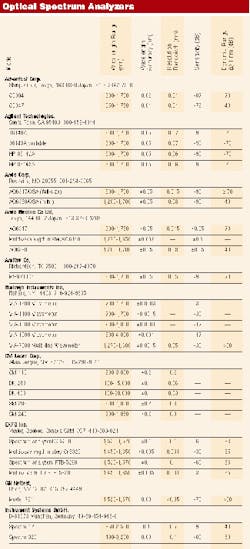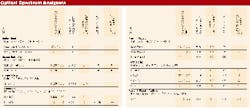DWDM presses for continuous improvement in OSAs
By Robert Pease
Due to a DWDM network's ever-narrowing spectral region, an increasing de mand for new types of test equipment has risen-equip ment that is acutely sensitive to wavelength. This has led to the development of, among other things, the optical spectrum analyzer (OSA). OSAs divide a light signal into its constituent wavelengths and measure the power of each wavelength, with results displayed graphically.
The OSA samples the optical spectrum using a narrow bandpass filter. The optical power is measured as the filter scans the wavelength range of interest, yielding a spectral plot of wavelength versus power. For DWDM system-measurement applications, the spectrum is analyzed and a channel table is extracted. The channel table gives channel-by-channel values for power, wavelength, and optical signal-to-noise ratio (OSNR). Other quantities, such as the number of active channels, gain slope, and gain tilt, are also commonly reported.
Optical spectrum analysis has applications in testing laser and light-emitting-diode (LED) light sources for spectral purity and power distribution, as well as testing transmission characteristics of optical devices. The spectral width of a light source is an important parameter in fiber-optic communication systems due to chromatic dispersion in fiber that limits the modulation bandwidth of the system.Chromatic dispersion effects are seen in the time domain as pulse broadening of a digital waveform. Since it is a function of the spectral width of the light source, narrow spectral widths are desirable for high-speed communication systems.
OSAs can be divided into several categories, the most common probably being diffraction-grating-based and two interferometer-based architectures (the Fabry-Perot and Michelson). Diffraction-grating-based OSAs are capable of measuring spectra of lasers and LEDs. The resolution of these instruments is variable, but typically ranges between 0.1 nm and 5 or 10 nm. Fabry-Perot interferometer-based OSAs have a fixed, narrow resolution, typically specified in frequency between 100 MHz and 10 GHz. This narrow resolution allows them to be used for measuring laser chirp, but can limit their measurement spans much more than the diffraction-grating-based OSAs.
Michelson interferometer-based OSAs, used for direct coherence-length measurements, display the spectrum by calculating the Fourier transform of a measured interference pattern. Burleigh Instruments Inc. (Fishers, NY) uses Michelson interferometer-based technology in its multiwavelength meter to analyze the optical DWDM signal in a slightly different way than the traditional OSA.
"The most compelling advantage of the multiwavelength meter is its high absolute wavelength accuracy due to its interferometer-based design and continuous calibration with a built-in wavelength standard," says Brian Samoriski, director of Burleigh's optical instruments division. "It can offer absolute wavelength accuracy as high as ±1 pm at 1,500 nm. This is not an advantage of an OSA system."OSA systems, says Samoriski, currently claim to provide an absolute wavelength accuracy of up to ±10 pm. However, OSAs also have advantages, the most compelling being their large optical dynamic range.
"Because of its scanning design, this type of instrument only measures the intensity of an optical signal at one particular wavelength at a time," explains Samoriski. "The result is an optical dynamic range on the order of 60 dB. Also, the sensitivity of an OSA is much better than a multiwavelength meter. The minimum optical output typically is as low as -90 dBm. The optical dynamic range of a multiwavelength meter is typically limited to about 35 dB."
The point is that no one instrument is ideal and the customer will ultimately decide which capability is most important.
The high-growth market for DWDM since it exploded onto the telecommunications scene has been the major catalyst for the development of OSAs as essential test equipment. Many believe OSAs to be the most important and most powerful test equipment for analyzing DWDM systems.
"The name of the game is time-to-market for optical designers and developers, and time-to-volume or -throughput for manufacturers," says Scott DeMange, product manager for the lightwave division of Agilent Technologies (Santa Rosa, CA). "Cost of test is critical in all cases. As such, customers now demand that OSAs provide them with faster and easier-to-use functionality, as well as maintain a very high level of accuracy and repeatability. This has placed the need on OSAs for fast-sweep speed, built-in test applications, ease of use, and high wavelength accuracy."
A major trend has been to develop OSAs that are no longer confined to the lab, but can be deployed out in the field.
"Until recently, spectrum analyzers using grating monochromators were designed for the stringent requirements of laboratory measurements," says Gerhard Lehmann, business-development manager for fiber-optic technologies at Wavetek Wandel Goltermann (WWG-Research Trian-gle Park, NC). "They were large, expensive and, in particular, mechanically sensitive. The rapid introduction of DWDM systems will result in an acute demand for portable OSAs that can be used in the field for installation, maintenance, and troubleshooting."
WWG believes instruments based on a grating monochromator offer the best prospects for portable OSAs if a combination of the best possible dynamic range, selectivity, and wavelength-measurement accuracy in a single instrument is required. They refer to these as DWDM analyzers, reflecting the implementation of features and functions required for DWDM installation and maintenance into a single instrument.
"Although most often the DWDM analyzer goes along with a more restricted wavelength than their big brothers," says WWG's Peter Winterling, product manager for fiber-optic test equipment in Central Europe, "they still fulfill the range specified by ITU-T, which is 1,450 to 1,650 nm. Also, the end users are very often network engineers and technicians working under extreme time pressure, and they appreciate auto-analysis functions and further possibilities for analyzing DWDM parameters, such as directly displaying the three major system parameters for each channel-wavelength, level, and OSNR."
Mike Wilder, field-marketing engineer at Anritsu Co. (Richardson, TX), says OSAs are following the same curve as optical time-domain reflectometers (OTDRs) and should continue to do so. Like the OTDRs, the manual measurement functions have become automated. Anritsu is also observing the trend of OSAs making the journey from the lab to the field.
"They're starting to convert OSAs from large lab units, also known as 'boat anchors,' to mini-OSAs," says Wilder. "As was the case with the first mini-OTDRs, the specifications and features of the mini-OSA cannot match the full-size instruments. As the installed DWDM systems add more and closer channels, however, smaller field units will catch up with their larger siblings in terms of performance."
One key to the success of the field units will be efficiency. Operators simply don't have the time needed for extensive training of personnel. Ideally, units should be simple to use, with communications tools built in to send results to more experienced personnel for further analysis. If data can't be sent directly to the lab, other options include hard drives or floppy disks for storing data for future analysis.
The evolution of software from the lab-oriented user interface to a more user-friendly interface will make portable units much more palatable for the customers. Ease-of-use features such as one-button testing, a live channel table, automatic file naming and saving functions, and automatic system-drift-analysis features will help reduce complexity.
Other trends in the OSA market include the move by the contractor world toward greater familiarity with DWDM systems, their testing requirements, and the portable OSA itself. The OSA is on the "short list" of essential test equipment for installers, alongside the loss test set and OTDR. Knowledge of these advanced testing applications for high-speed or multichannel systems will likely be an important part of a contractor's competitive edge.
"A key for contractors is the ability to intelligently interpret the data as the testing progresses, not just gather it together at the end of the week and put it into a binder," says John Marsh, director of all-optical network solutions at GN Nettest (Utica, NY). "Another trend is the move toward L-band testing. Although DWDM systems operating in the L-band are still mostly in the developmental stages, operators and installers see the need to be ready for the wider spectral range when the technology finally arrives."
Marsh also points out a move toward offering channel-drop capabilities for bit-error rate (BER) and other tests. A wide range of instrumentation that was used for signal analysis on single-channel systems, such as 1,550 nm, is now in need of an optical fiber that will drop just one DWDM channel for analysis, says Marsh.


